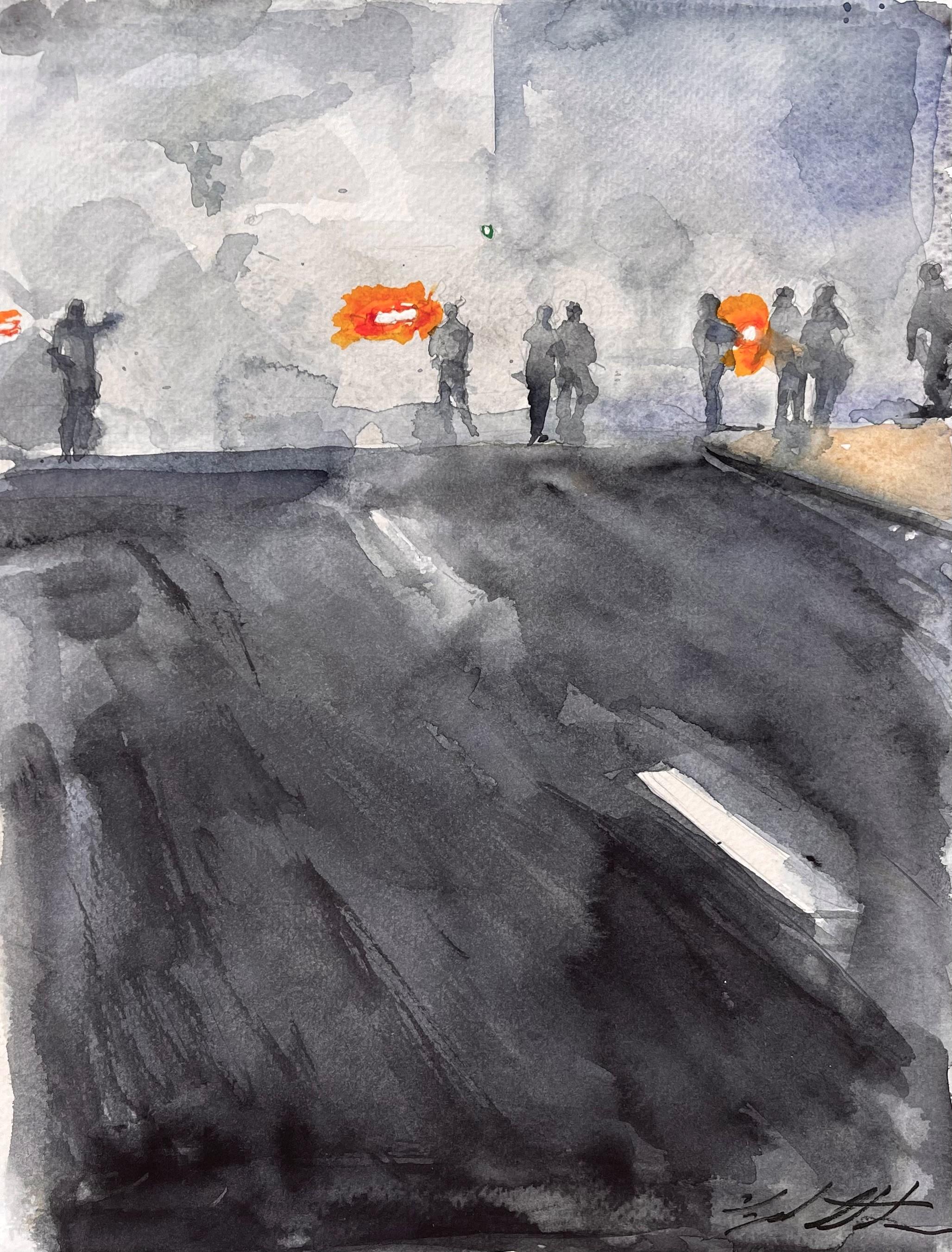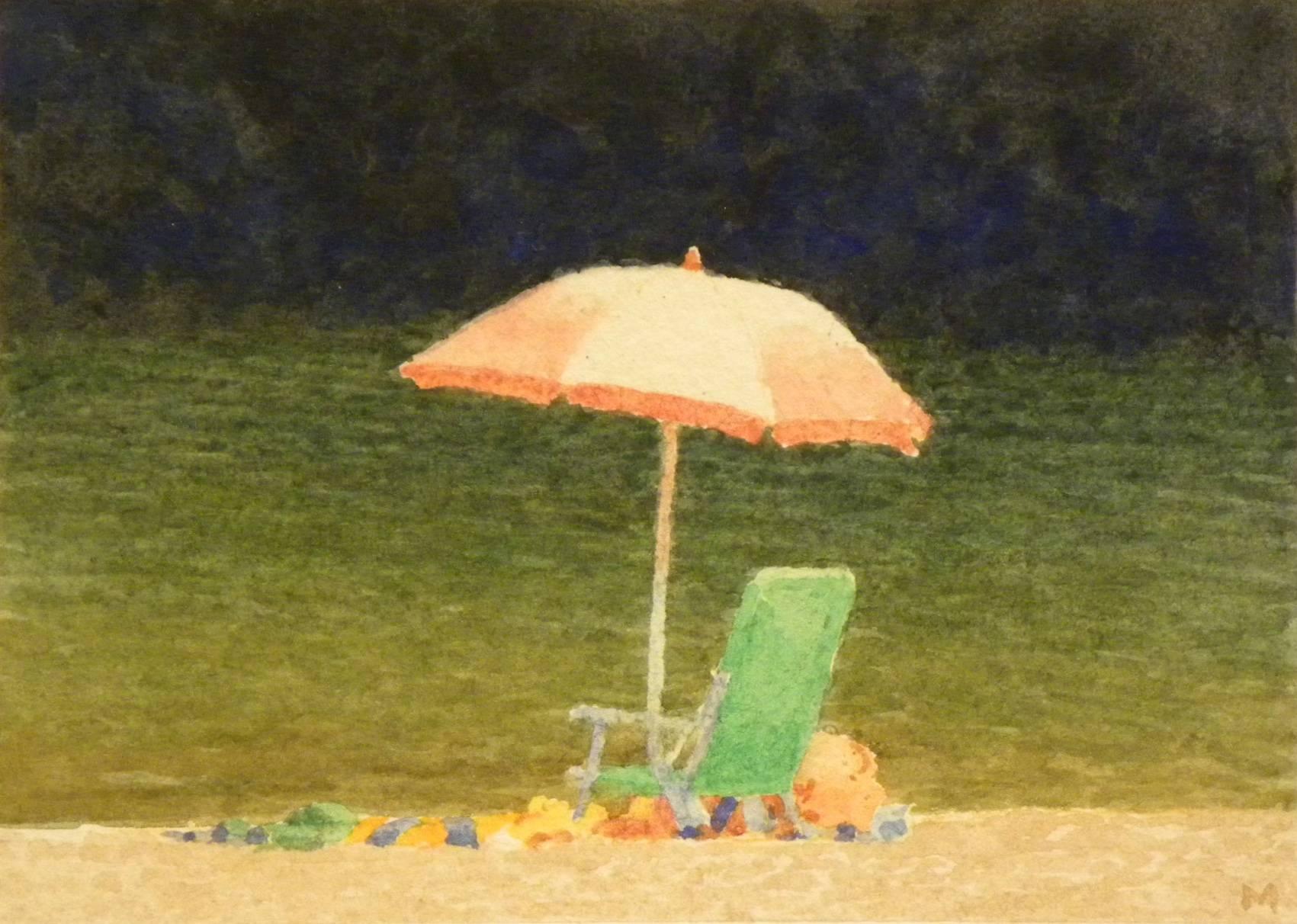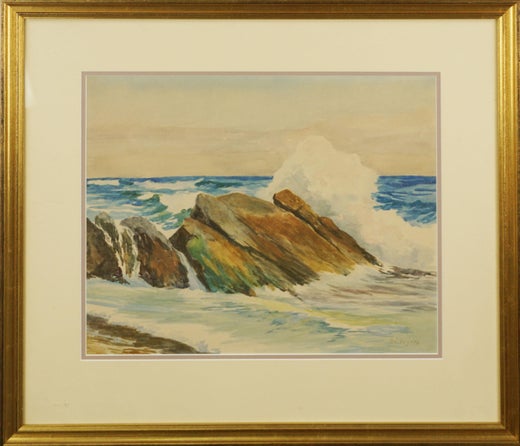Margaret Esther RogersMid Century Crashing Surf on Rocks SeascapeCirca 1950
Circa 1950
About the Item
- Creator:Margaret Esther Rogers (1872 - 1961, American)
- Creation Year:Circa 1950
- Dimensions:Height: 25 in (63.5 cm)Width: 27 in (68.58 cm)Depth: 1 in (2.54 cm)
- Medium:
- Movement & Style:
- Period:
- Condition:Good; Wear consistent with age. Some age toning to mat. Vintage frame may show signs of wear consistent with age and history. Minor cosmetic issues will be minimized but may not be restored to original condition. New hanging hardware installed.
- Gallery Location:Soquel, CA
- Reference Number:
Margaret Esther Rogers
Margaret Esther Rogers grew up in the curiously paradoxical world of early California, breaking her riding horses and roping cattle during the day, doing a man’s work, riding a man’s saddle, then sitting down to the piano to play classics in the evening after high tea. Margaret’s mother had the only piano for 80 miles around. Her father, Robert J. Rogers, had been an importer of fine tea, coffee and spices in England. In Monterey County, he raised sheep and cattle and the family lived under comparatively primitive conditions. When Margaret wasn’t riding, tending a herd, plowing a field, or playing the piano, she was painting. Art was an early love. Fame caught up with her early. She was written up in a San Francisco newspaper as “Monterey County’s pretty girl who rides a man’s saddle, marks and brands stock, breaks wild colts, plows and sows, plays classical music and paints in oils.” Margaret’s mother was her first music and art teacher; later she took art lessons from Kate Baldwin in Salinas. She had suitors and several proposals but never married. In the year 1898, Margaret’s “intended” put in 700 acres of grain, spending all she had plus the money she borrowed. Not a spear of grain grew, she wrote, and their plans to marry when the crop was sold dried up with the weather.
When her mother died, Margaret and her father moved to Soquel, taking along her favorite saddle horse. Now living in Santa Cruz County, Margaret at once became involved in art circles, which were unofficially headed by Frank Heath and his wife, Lillian Dake Heath. Frank Heath and Margaret together founded Santa Cruz Art League in 1919, and a few months later were joined in their efforts by a Dutch woman named Cor de Gavere, who arrived in Santa Cruz. The two women artists, Margaret and Cor, became fast friends and remained so until Cor’s death in July 1955, while she was visiting relatives in Holland. They painted together almost every day and shared many meals at each other’s cottages, which were just a few blocks apart in the Seabright area. However, those Victorian ladies, raised in the era of rigid social conventions, always addressed each other as “Miss Rogers” and “Miss de Gavere” as long as they lived. Money was never in great supply for either lady, but Cor managed to buy a small automobile, and after six driving lessons, the two of them took off for southern California. Cor and Margaret took many camping and painting trips in Cor’s automobile. Sometime later, Margaret herself got brave enough to buy an auto. From 1925–47, Margaret made her home in the basement of the Arts and Crafts Building. She managed the Art League’s first gallery, which was started there. Holding informal court for friends who called, Margaret would open a can of sardines, put out a plate of crackers, and conversation about art or music would follow.
During World War II, Margaret raised rabbits in cages. In later years, Margaret purchased a small studio-home on Alhambra Street — still in the Seabright area, which both women clung to as home territory. In 1929, Margaret helped found the Art League’s first Statewide Show, which became an annual event. She served as a show chairwoman for more than 20 years. A fine painter of landscapes, Margaret became better known for her strong marine scenes. Once she explained that the ocean was, “the real challenge, because it won’t stand still.” She served as president of the Art League from 1925–47. Short, stocky, outspoken and very talented, Margaret gained many honors in her later years. With her short haircut and her dark dresses, she was a familiar sight at local musicals and always at art events. Someone who knew both Cor and Margaret very well once described them this way: “Cor was the gentle gray dove, Margaret was the noisier, more aggressive blue jay.”
(Biography provided by Robert Azensky Fine Art)- ShippingRetrieving quote...Ships From: Soquel, CA
- Return PolicyA return for this item may be initiated within 14 days of delivery.
- The Old Barn - Farmhouse Landscape in Watercolor on PaperLocated in Soquel, CAIdyllic farmhouse landscape by California artist Edwin Haas (American, 1927-2010). A barn with a boarded window is the primary focus of this piece. It is seated in a lush landscape, full of grass, with a small stream running through the center. To the right of the barn is a bare oak tree, and steps can be seen leading to another building. A Sacramento artist...Category
Mid-20th Century American Impressionist Landscape Drawings and Watercolors
MaterialsWatercolor, Laid Paper
- Trees and Rolling Hills Landscape - Gouache on PaperLocated in Soquel, CASmall landscape with large trees by M. J. (Charles) Karnoff (Russian-American). Several large trees occupy the left side of the frame, lining a simple fence. There are some rolling hills in the background, with smaller trees on the horizon. Initialed "M.J.K." in lower right corner. Presented in a new off-white mat...Category
Early 20th Century American Impressionist Landscape Drawings and Waterco...
MaterialsPaper, Gouache
- Methodist Church in Old Bodie Ghost Town - California - Watercolor on PaperLocated in Soquel, CAMethodist Church in Bodie California - Watercolor on Paper Delightful watercolor by California artist Rachel Bentley (American, 1894-1991). The scene d...Category
Mid-20th Century American Impressionist Landscape Drawings and Watercolors
MaterialsPaper, Watercolor
- Farmhouse by the Sea - Original Watercolor on PaperLocated in Soquel, CAFarmhouse by the Sea - Original Watercolor on Paper Tranquil landscape of a seaside farmhouse on the sand surrounded by coastal plants, in soft neutral watercolors. A distant ocean s...Category
Late 20th Century American Impressionist Landscape Drawings and Watercolors
MaterialsPaper, Watercolor
- Two Anchored Sailboats - Nautical Seascape in Watercolor on PaperLocated in Soquel, CASerene depiction of two sailboats by an unknown artist (20th Century). Two boats are anchored in greenish water. The blue sky has some puffy clouds, and takes up roughly two thirds o...Category
Mid-20th Century American Impressionist Landscape Drawings and Watercolors
MaterialsLaid Paper, Watercolor
- Whalers Shack on the Northern California Coast - Watercolor SeascapeLocated in Soquel, CASerene depiction of a Whaling shack circa 1900 near Davenport, California attributed to Lillian Josephine (Dake) Heath (19th century). Monogram on Verso "J. H. 1900". Dated and initialed on verso "J. H. Feb. 1900" Presented in a new white mat with foam core backing. Mat size: 14"H x 18"W Paper size: 9.25"H x 13.25"W Lillian Heath was one of the Jolly Daubers at the turn of the 19th-century and as a young student, married the senior artist and instructor, Frank Heath...Category
Early 1900s American Impressionist Landscape Drawings and Watercolors
MaterialsWatercolor, Archival Paper
- The Rapids (Maine)By John WhorfLocated in Provincetown, MAJohn Whorf, born in 1903, was a talented, opinionated artist who achieved great success at a young age. Encouraged by his artistic father, Whorf studied briefly during his early te...Category
Early 20th Century American Impressionist Landscape Drawings and Waterco...
MaterialsPaper, Watercolor
- "Untitled 1, " Watercolor PaintingLocated in Denver, COClyde Steadman's "Untitled 1" is an original, handmade watercolor painting that depicts an urban landscape with human silhouettes.Category
2010s American Impressionist Figurative Drawings and Watercolors
MaterialsPaper, Watercolor
- "Train Station, " Max Kuehne, Industrial City Scene, American ImpressionismBy Max KuehneLocated in New York, NYMax Kuehne (1880 - 1968) Train Station, circa 1910 Watercolor on paper 8 1/4 x 10 1/4 inches Signed lower right Provenance: Private Collection, Illinois Max Kuehne was born in Halle, Germany on November 7, 1880. During his adolescence the family immigrated to America and settled in Flushing, New York. As a young man, Max was active in rowing events, bicycle racing, swimming and sailing. After experimenting with various occupations, Kuehne decided to study art, which led him to William Merritt Chase's famous school in New York; he was trained by Chase himself, then by Kenneth Hayes Miller. Chase was at the peak of his career, and his portraits were especially in demand. Kuehne would have profited from Chase's invaluable lessons in technique, as well as his inspirational personality. Miller, only four years older than Kuehne, was another of the many artists to benefit from Chase's teachings. Even though Miller still would have been under the spell of Chase upon Kuehne's arrival, he was already experimenting with an aestheticism that went beyond Chase's realism and virtuosity of the brush. Later Miller developed a style dependent upon volumetric figures that recall Italian Renaissance prototypes. Kuehne moved from Miller to Robert Henri in 1909. Rockwell Kent, who also studied under Chase, Miller, and Henri, expressed what he felt were their respective contributions: "As Chase had taught us to use our eyes, and Henri to enlist our hearts, Miller called on us to use our heads." (Rockwell Kent, It's Me O Lord: The Autobiography of Rockwell Kent. New York: Dodd, Mead and Co., 1955, p. 83). Henri prompted Kuehne to search out the unvarnished realities of urban living; a notable portion of Henri's stylistic formula was incorporated into his work. Having received such a thorough foundation in art, Kuehne spent a year in Europe's major art museums to study techniques of the old masters. His son Richard named Ernest Lawson as one of Max Kuehne's European traveling companions. In 1911 Kuehne moved to New York where he maintained a studio and painted everyday scenes around him, using the rather Manet-like, dark palette of Henri. A trip to Gloucester during the following summer engendered a brighter palette. In the words of Gallatin (1924, p. 60), during that summer Kuehne "executed some of his most successful pictures, paintings full of sunlight . . . revealing the fact that he was becoming a colorist of considerable distinction." Kuehne was away in England the year of the Armory Show (1913), where he worked on powerful, painterly seascapes on the rocky shores of Cornwall. Possibly inspired by Henri - who had discovered Madrid in 1900 then took classes there in 1906, 1908 and 1912 - Kuehne visited Spain in 1914; in all, he would spend three years there, maintaining a studio in Granada. He developed his own impressionism and a greater simplicity while in Spain, under the influence of the brilliant Mediterranean light. George Bellows convinced Kuehne to spend the summer of 1919 in Rockport, Maine (near Camden). The influence of Bellows was more than casual; he would have intensified Kuehne's commitment to paint life "in the raw" around him. After another brief trip to Spain in 1920, Kuehne went to the other Rockport (Cape Ann, Massachusetts) where he was accepted as a member of the vigorous art colony, spearheaded by Aldro T. Hibbard. Rockport's picturesque ambiance fulfilled the needs of an artist-sailor: as a writer in the Gloucester Daily Times explained, "Max Kuehne came to Rockport to paint, but he stayed to sail." The 1920s was a boom decade for Cape Ann, as it was for the rest of the nation. Kuehne's studio in Rockport was formerly occupied by Jonas Lie. Kuehne spent the summer of 1923 in Paris, where in July, André Breton started a brawl as the curtain went up on a play by his rival Tristan Tzara; the event signified the demise of the Dada movement. Kuehne could not relate to this avant-garde art but was apparently influenced by more traditional painters — the Fauves, Nabis, and painters such as Bonnard. Gallatin perceived a looser handling and more brilliant color in the pictures Kuehne brought back to the States in the fall. In 1926, Kuehne won the First Honorable Mention at the Carnegie Institute, and he re-exhibited there, for example, in 1937 (Before the Wind). Besides painting, Kuehne did sculpture, decorative screens, and furniture work with carved and gilded molding. In addition, he designed and carved his own frames, and John Taylor Adams encouraged Kuehne to execute etchings. Through his talents in all these media he was able to survive the Depression, and during the 1940s and 1950s these activities almost eclipsed his easel painting. In later years, Kuehne's landscapes and still-lifes show the influence of Cézanne and Bonnard, and his style changed radically. Max Kuehne died in 1968. He exhibited his work at the National Academy of Design, the Art Institute of Chicago, the Carnegie Institute in Pittsburgh, the Memorial Art Gallery of the University of Rochester, and in various New York City galleries. Kuehne's works are in the following public collections: the Detroit Institute of Arts (Marine Headland), the Whitney Museum (Diamond Hill...Category
1910s American Impressionist Landscape Drawings and Watercolors
MaterialsPaper, Watercolor
- "Cloudy Dock Scene", working peir with fishermen, boats, and architectureBy John Cuthbert HareLocated in Rockport, MAJohn Cuthbert Hare was an accomplished New England painter born in Brooklyn, New York. He began his artistic journey by studying commercial art at the Pratt Institute in New York Cit...Category
Mid-20th Century American Impressionist Landscape Drawings and Watercolors
MaterialsPaper, Watercolor
- Pink Umbrella. Green ChairBy Mary RobertsonLocated in Burlingame, CASerene river scene watercolor from important Bay Area figurative contemporary artists Mary Robertson, who is associated with the Bay Area Figurative School, founded by Elmer Bischoff...Category
2010s American Impressionist Landscape Drawings and Watercolors
MaterialsPaper, Watercolor
- Canal at Indian Mound RoadBy Ben FenskeLocated in Sag Harbor, NYPainted during the 2015 Winter Equestrian Festival in Wellington, Florida. A black and white depiction of a canal, is barely recognizable, due to Fenske's wild brushstrokes and lack...Category
21st Century and Contemporary American Impressionist Landscape Paintings
MaterialsGouache, Paper





